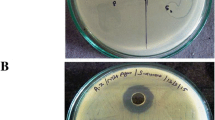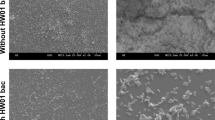Abstract
This study aimed to produce the novel bacteriocin from Pseudomonas aeruginosa 43. The bacteriocin was purified through 80% ammonium sulfate precipitation, cation exchange chromatography, and gel filtration, and the specific antimicrobial activity was 400 AU/ml of protein. The molecular weight of purified bacteriocin was 10 kDa determined by SDS-PAGE. It was shown to be heat stable at 121 °C for 30 min and functioned well at low pH in a range of 3–7. Reduction of activity was shown after treatment with proteinase K, trypsin, papain, and α-amylase that confirmed its proteinaceous nature. Bacteriocin also showed its stability against various organic solvents and chemical reagents. Scanning electron microscope analysis indicated that bacteriocin from P. aeruginosa 43 damaged the morphology of methicillin-resistant Staphylococcus aureus (MRSA). Also, the novel bacteriocin exhibited an enhanced ability to impair biofilm formation and to reduce the density of established biofilms. LC–MS analysis study showed elastase is a novel peptide produced by P. aeruginosa 43 which has broad spectrum of inhibition against MRSA. The study suggested that bacteriocin from P. aeruginosa 43 could be developed as a antimicrobial agent for skin infection.








Similar content being viewed by others
References
Abdulgader SM, Shittu AO, Nicol MP, Kaba M (2015) Molecular epidemiology of Methicillin-resistant Staphylococcus aureus in Africa: a systematic review. Front Microbiol 6:348
Boulos L, Prevost M, Barbeau B, Coallier J, Desjardins R (1999) LIVE/DEAD BacLight: application a new rapid staining method for direct enumeration of viable and total bacteria in drinking water. J Microbiol Methods 37:77–86
Bunthof CJ, van Schalkwijk S, Meijer W, Abee T, Hugenholtz J (2001) Fluorescent method for monitoring cheese starter permeabilization and lysis. Appl Environ Microbiol 67:4264–4271
Cavera VL, Volski A, Chikindas ML (2015) The natural antimicrobial Subtilosin A synergizes with lauramide arginine ethyl ester (LAE), ε-Poly-L-lysine (Polylysine), clindamycin phosphate and metronidazole, against the vaginal pathogen Gardnerella vaginalis. Probiotics Antimicrob Proteins 7:164–171
Chaudhary D, Subhash A, Galvis J, Guardiola J (2017) Bilateral thigh methicillin-resistant Staphylococcus aureus necrotising fasciitis in a man with newly diagnosed Human Immunodeficiency Virus (HIV). BMJ Case Rep. https://doi.org/10.1136/bcr-2016-218468
Decker EM (2001) the ability of direct fluorescence-based, two-colour assays to detect different physiological states of oral streptococci. Lett Appl Microbiol 33:188–192
Deraz SF, Karlsson EN, Hedstrom M, Andersson MM, Mattiasson B (2005) Purification and characterization of acidocin D20079, a bacteriocin produced by Lactobacillus acidophilus DSM 20079. J Biotechnol 117:343–354
Dimitrov S, Waschsman M, Tome E, Dousset X, Teresa M, Milner L (2010) Characterization of an antiviral pediocin like bacteriocin produced by Enterococcus faecium. Food Microbiol 27:869–879
Eijsink VGH, Skeie M, Middelhoven PH, Brurberg MB, Nes IF (1998) Comparative studies of class IIa bacteriocins of lactic acid bacteria. Appl Environ Microbiol 64:3275–3281
Gautam N, Sharma N (2009) Bacteriocin: safest approach to preserve food products. Indian J Microbiol 49:204–211
Ghanbari M, Jami M, Kneifel W, Domig KJ (2013) Antimicrobial activity and partial characterization of bacteriocins produced by Lactobacilli isolated from Sturgeon fish. Food Control 32:379–385
Giuliani A, Pirri G, Nicoletto SF (2007) Antimicrobial peptides: an overview of a promising class of therapeutics. Cent Eur Biol 2(1):1–33
Hammami R, Fernandez B, Lacroix C, Fliss I (2013) Anti-infective properties of bacteriocins: an update. Cell Mol Life Sci 70(16):2947–2967
Hassan M, Kjos M, Nes IF, Diep DB, Lotfipour F (2012) Natural antimicrobial peptides from bacteria: characteristics and potential applications to fight against antibiotic resistance. J Appl Microbiol 113:723–736
Hussein HJ, Hadi MY, Hameed IH (2016) Study of chemical composition of Foeniculum vulgare using Fourier transform infrared spectrophotometer and gas chromatography–mass spectrometry. J Pharmacol Phytother 8(3):60–89
Jhample SB, Bhagwat PK, Dandge PB (2015) Statistical media optimization for enhanced production of fibrinolytic enzyme from newly isolated Proteus penneri SP-20. Biocatal Agric Biotechnol 4:370–379
Kaskoniene V, Mantas S, Kristina BS, Gintarė N, Loreta S, Kristina M, Mindaugas M, Audrius M (2017) Current state of purification, isolation and analysis of bacteriocins produced by lactic acid bacteria. Appl Microbiol Biotechnol 101:1323–1335
Kaskoniene V, Maruska A, Akuneca I, Stankevicius M, Ragazinskiene O, Bartkuviene V, Kornysova O, Briedis V, Ugenskiene R (2015) Screening of antioxidant activity and volatile compounds composition of Chamerion angustifolium (L.) Holub ecotypes grown in Lithuania. Nat Prod Res 29:1–9
Kaskoniene V, Stankevicius M, Drevinskas T, Akuneca I, Kaskonas P, Bimbiraite-Surviliene K, Maruska A, Ragazinskiene O, Kornysova O, Briedis V, Ugenskiene R (2015) Evaluation of phytochemical composition of fresh and dried raw material of introduced Chamerion angustifolium L. using chromatographic, spectrophotometric and chemometric techniques. Phytochemistry 115:184–193
Kellner R, jung G, Horner T, Ziihner H, Schnell N, Entian KD, Gotz P (1988) Gallidermin: a new lanthionine-containing polypeptide antibiotic. Eur J Biochem 177:53–59
Li J, Kolling GL, Matthews KR, Chikindas ML (2003) Cold and carbon dioxide used as multi-hurdle preservation do not induce appearance of viable but non-culturable Listeria monocytogenes. J Appl Microbiol 94:48–53
Maruska KP, Fernald RD (2014) Social regulation of gene expression in the African cichlid fish Astatotilapia burtoni. In: Canli T (ed) The Oxford handbook of molecular psychology. Oxford University Press, New York, pp 52–78
Masia A, Varela MS, Gonzalez AL, Pico Y (2016) Determination of pesticides and veterinary drug residues in food by liquid chromatography–mass spectrometry. Anal Chim Acta 936:40–61
Nakamura T, Yamazaki N, Taniguchi H, Fujimura S (1983) Production, purification and properties of a bacteriocin from Staphylococcus aureus isolated from saliva. Infect Immun 39:609–614
Nohynek L, Saski E, Haikara A, Raaska L (2003) Detection of bacterial contamination in starch and resin based papermaking chemicals using fluorescence techniques. J Ind Microbiol Biotechnol 30:239–244
Remane D, Wissenbach DK, Peters FT (2016) Recent advances of liquid chromatography–(tandem) mass spectrometry in clinical and forensic toxicology an update. Clin Biochem 49:1051–1071
Risoen PA, Ronning P, Hegna IK, Kolsto AB (2004) Characterization of a broad range antimicrobial substance from Bacillus cereus. J Appl Microbiol 96:648–655
Saleem F, Ahmed S, Yaqoob Z, Rasool SA (2009) Comparative study of two bacteriocins produced by representative indigenous soil bacteria. Pak J Pharm Sci 22(3):252–258
Sequeiros C, Garces ME, Vallejo M, Marguet ER, Olivera NL (2015) Potential aquaculture probiont Lactococcus lactis TW34 produces nisin Z and inhibits the fish pathogen Lactococcus garvieae. Arch Microbiol 197:449–458
Shaaban H (2016) New insights into liquid chromatography for more eco-friendly analysis of pharmaceuticals. Anal Bioanal Chem 408:6929–6944
Sharma N, Kapoor R, Gautam N, Kumari R (2011) Purification and characterization of bacteriocin produced by Lactobacillus sp. A75 isolated from fermented chunks of Phaseolus radiata. Food Technol Biotechnol 49(2):169–176
Vijayakumar PP, Muriana PM (2015) A microplate growth inhibition assay for screening bacteriocins against Listeria monocytogenes to differentiate their mode-of-action. Biomolecules 5(2):1178–1194
Xie J, Zhang R, Shang C, Guo Y (2009) Isolation and characterization of a bacteriocin produced by an isolated Bacillus subtilis LFB112 that exhibits antimicrobial activity against domestic animal pathogens. Afr J Biotechnol 8:5611–5619
Yang SC, Lin CH, Sung CT, Fang JY (2014) Antibacterial activities of bacteriocins: application in foods and pharmaceuticals. Front Microbiol 5:241
Yi L, Dang Y, Wu J, Zhang L, Liu X, Liu B (2016) Purification and characterization of a novel bacteriocin produced by Lactobacillus crustorum MN047 isolated from koumiss from Xinjiang, China. J Dairy Sci 99:7002–7015
Acknowledgements
The authors gratefully acknowledge the Department of Science and Technology, New Delhi for providing financial supports under the DST-WOS-A start of Grant for (DST/SR/WOS- A/LS-629/2012(G)), Scheme. Also the Department of Biological Science and Technology, National Pingtung University of Science and Technology, Taiwan for providing financial supports and lab specialty.
Author information
Authors and Affiliations
Corresponding author
Ethics declarations
Conflict of interest
The authors declare that they have no conflict of interest.
Ethical Approval
This article does not contain any studies with human participants or animals performed by any of the authors.
Additional information
Publisher's Note
Springer Nature remains neutral with regard to jurisdictional claims in published maps and institutional affiliations.
Rights and permissions
About this article
Cite this article
Selvam, D., Thangarasu, A., Shyu, D.J.H. et al. Antimicrobial Substance Produced by Pseudomonas aeruginosa Isolated from Slaughterhouse Sediment: Physicochemical Characterization, Purification, and Identification. Int J Pept Res Ther 27, 887–897 (2021). https://doi.org/10.1007/s10989-020-10135-2
Accepted:
Published:
Issue Date:
DOI: https://doi.org/10.1007/s10989-020-10135-2




